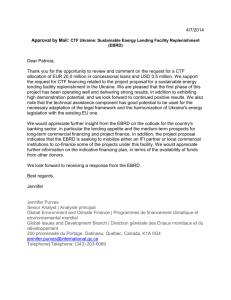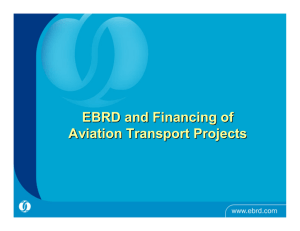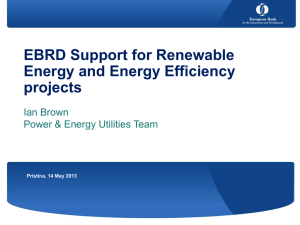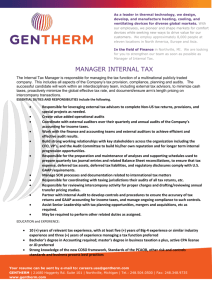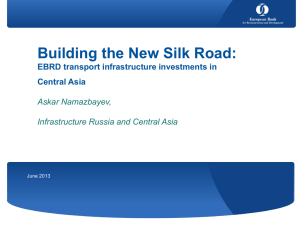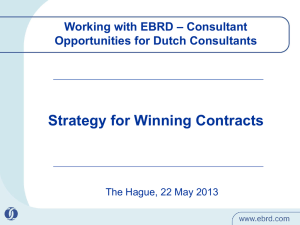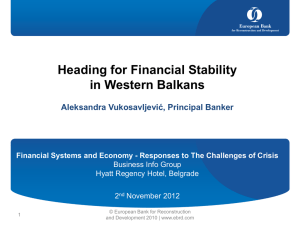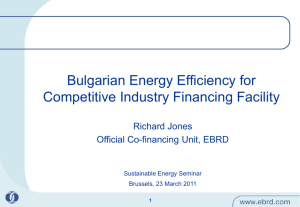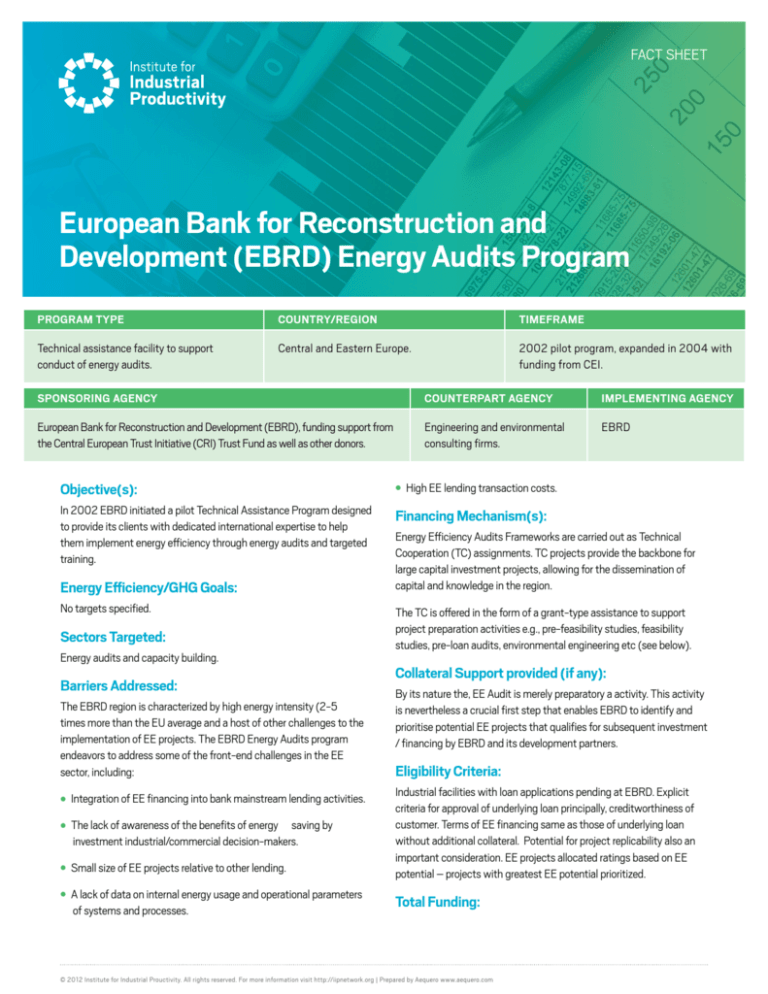
FACT SHEET
Institute for Industrial Productivity
Delivery Vehicles for Financing of Industrial Energy Efficiency - A Collection of Best Practices
European Bank for Reconstruction and
Development (EBRD) Energy Audits Program
PROGRAM TYPE
COUNTRY/REGION
TIMEFRAME
Technical assistance facility to support
conduct of energy audits.
Central and Eastern Europe.
2002 pilot program, expanded in 2004 with
funding from CEI.
SPONSORING AGENCY
COUNTERPART AGENCY
IMPLEMENTING AGENCY
European Bank for Reconstruction and Development (EBRD), funding support from
the Central European Trust Initiative (CRI) Trust Fund as well as other donors.
Engineering and environmental
consulting firms.
EBRD
Objective(s):
High EE lending transaction costs.
ll
l
In 2002 EBRD initiated a pilot Technical Assistance Program designed
to provide its clients with dedicated international expertise to help
them implement energy efficiency through energy audits and targeted
training.
Financing Mechanism(s):
Energy Efficiency Audits Frameworks are carried out as Technical
Cooperation (TC) assignments. TC projects provide the backbone for
large capital investment projects, allowing for the dissemination of
capital and knowledge in the region.
Energy Efficiency/GHG Goals:
No targets specified.
The TC is offered in the form of a grant-type assistance to support
project preparation activities e.g., pre-feasibility studies, feasibility
studies, pre-loan audits, environmental engineering etc (see below).
Sectors Targeted:
Energy audits and capacity building.
Collateral Support provided (if any):
Barriers Addressed:
By its nature the, EE Audit is merely preparatory a activity. This activity
is nevertheless a crucial first step that enables EBRD to identify and
prioritise potential EE projects that qualifies for subsequent investment
/ financing by EBRD and its development partners.
The EBRD region is characterized by high energy intensity (2-5
times more than the EU average and a host of other challenges to the
implementation of EE projects. The EBRD Energy Audits program
endeavors to address some of the front-end challenges in the EE
sector, including:
Eligibility Criteria:
Industrial facilities with loan applications pending at EBRD. Explicit
criteria for approval of underlying loan principally, creditworthiness of
customer. Terms of EE financing same as those of underlying loan
without additional collateral. Potential for project replicability also an
important consideration. EE projects allocated ratings based on EE
potential – projects with greatest EE potential prioritized.
Integration of EE financing into bank mainstream lending activities.
ll
l
The lack of awareness of the benefits of energy saving by
investment industrial/commercial decision-makers.
ll
l
Small size of EE projects relative to other lending.
ll
l
A lack of data on internal energy usage and operational parameters
of systems and processes.
ll
l
Total Funding:
49
© 2012 Institute for Industrial Prouctivity. All rights reserved. For more information visit http://iipnetwork.org | Prepared by Aequero www.aequero.com
European
Bank Productivity
for Reconstruction and
Institute for Industrial
Delivery Vehicles for(EBRD)
Financing ofEnergy
Industrial Energy
Efficiency
- A Collection of Best Practices
Development
Audits
Program
Between 2004 and 2009 CEI allocated EUR 1.2 million to TC EE
projects. EBRD report that the first two Energy Audit Programs
financed by CEI resulted led to EE investments of EUR 87.3 million1.
FACT SHEET
3. Challenges with reliable data collection: The lack of accurate /
reliable data on some facilities leads to challenges in estimating
actual energy usage during energy audits and, therefore, in
estimating the capital expenditure and potential savings. Sensitivity
analysis is necessary to assess potential risks in this regard.
Major Activities:
TCs are typically aimed at the following project preparatory activities:
4. Developing country challenges: Often in developing countries
modern state-of-the-art equipment is installed side-by-side with
obsolete equipment impacting the efficiency and productivity
of production process, which is determined by the least reliable
process component. This may require the EE auditor to step outside
the strict boundaries of an EE audit and take a holistic perspective
of the production process and opportunities for productivity
improvement.
1. Pre-feasibility studies
2. Feasibility studies
3. Sector / environmental engineering
4. Management training / capacity building programs
5. Pre-loan audits
In particular, Energy Audits, which are the core activity of the program,
typically encompass the following activities:
5. Capacity building: Capacity building / training of local management
and service firms is critical to enable local management (i) to assist
in identifying EE opportunities, (ii) to achieve buy-in from local
management for the EE imitative and (iii) to ensure management
capacity to implement EE initiative and operate and maintain EE
installations to realize anticipated energy savings. Hence, energy
management training for participating companies has been added
to project-oriented EE assessment.
a. Energy efficiency audit
b. Prioritization of EE investment plan
c. Energy management assessment
d. Local involvement and management (capacity building)
Key Results:
Contact(s):
Between 2004 and 2009 the CEI funded Energy Audits Program
identified EUR 201 million of potential investments that would lead to
total energy savings of 15.4 million GJ/year and abatement of 1.3 mt
CO2/year.
Energy Efficiency and Climate Change, EBRD
One Exchange Square
London EC2A 2JN
United Kingdom
Tel: +44 20 7338 6000
Fax: +44 20 7338 6100
EBRD reported the aggregate impact of 4.7 mt CO2/year reduction
in GHG emissions from 29 significant energy efficiency projects
(including EE with capacity expansion and RE/EE funds and credit
lines) committed to in 2011.
Reports/Publications:
Lessons Learned:
EBRD 2009. Impact Assessment of Energy Audit Programs.
1. High return from EE Audits: For relatively low capital outlay (TC
Other Comments:
assignments), EBRD is able to identify and prioritise potential
EE opportunities among clients and direct investment to those
opportunities that will realize the highest return; program average
50:1 EE investment to program expenditures.
The EBRD program is regarded as best practice among EE audit
programs and is presently being emulated by other agencies (as well
as private sector entities) in other markets. The Energy Audits initiative
was a precursor to subsequent Sustainable Energy Finance Facilities
(SEFFs) implemented by EBRD in Eastern Europe and former Soviet
Union (FSU) countries under the EBRD Sustainable Finance Imitative,
which provided for embedded technical assistance, including energy
audits.
2. Independence of EE Auditor: This is critical to have an external
and impartial result and to achieve buy-in from local management.
EBRD or International expert paired with local technical firms.
1
EBRD 2009. Impact Assessment of Energy Audit Programs.
2200 Pennsylvania Avenue, N.W., 4th Floor, East Tower, Washington, D.C. 20037 U.S.A.
iipnetwork.org | info@iipnetwork.org | Twitter.com/iipnetwork
50

